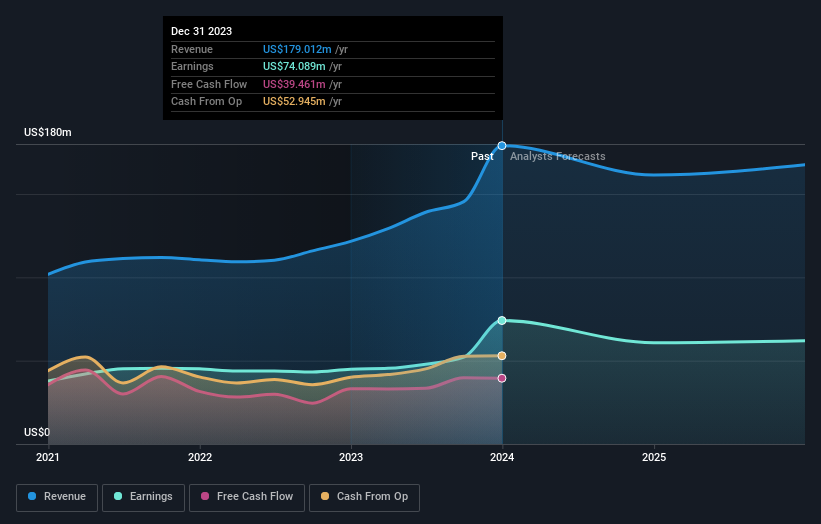Stock Analysis
- United States
- /
- Banks
- /
- NasdaqCM:BFC
Both retail investors who control a good portion of Bank First Corporation (NASDAQ:BFC) along with institutions must be dismayed after last week's 6.2% decrease

Key Insights
- The considerable ownership by retail investors in Bank First indicates that they collectively have a greater say in management and business strategy
- The top 25 shareholders own 42% of the company
- Recent purchases by insiders
Every investor in Bank First Corporation (NASDAQ:BFC) should be aware of the most powerful shareholder groups. The group holding the most number of shares in the company, around 51% to be precise, is retail investors. That is, the group stands to benefit the most if the stock rises (or lose the most if there is a downturn).
While the holdings of retail investors took a hit after last week’s 6.2% price drop, institutions with their 30% holdings also suffered.
Let's delve deeper into each type of owner of Bank First, beginning with the chart below.
See our latest analysis for Bank First

What Does The Institutional Ownership Tell Us About Bank First?
Institutional investors commonly compare their own returns to the returns of a commonly followed index. So they generally do consider buying larger companies that are included in the relevant benchmark index.
Bank First already has institutions on the share registry. Indeed, they own a respectable stake in the company. This suggests some credibility amongst professional investors. But we can't rely on that fact alone since institutions make bad investments sometimes, just like everyone does. If multiple institutions change their view on a stock at the same time, you could see the share price drop fast. It's therefore worth looking at Bank First's earnings history below. Of course, the future is what really matters.

Bank First is not owned by hedge funds. The company's largest shareholder is BlackRock, Inc., with ownership of 6.9%. For context, the second largest shareholder holds about 6.6% of the shares outstanding, followed by an ownership of 5.7% by the third-largest shareholder. In addition, we found that Michael Molepske, the CEO has 1.2% of the shares allocated to their name.
On studying our ownership data, we found that 25 of the top shareholders collectively own less than 50% of the share register, implying that no single individual has a majority interest.
While it makes sense to study institutional ownership data for a company, it also makes sense to study analyst sentiments to know which way the wind is blowing. There is a little analyst coverage of the stock, but not much. So there is room for it to gain more coverage.
Insider Ownership Of Bank First
The definition of company insiders can be subjective and does vary between jurisdictions. Our data reflects individual insiders, capturing board members at the very least. Company management run the business, but the CEO will answer to the board, even if he or she is a member of it.
Insider ownership is positive when it signals leadership are thinking like the true owners of the company. However, high insider ownership can also give immense power to a small group within the company. This can be negative in some circumstances.
Our information suggests that insiders maintain a significant holding in Bank First Corporation. Insiders own US$147m worth of shares in the US$799m company. We would say this shows alignment with shareholders, but it is worth noting that the company is still quite small; some insiders may have founded the business. You can click here to see if those insiders have been buying or selling.
General Public Ownership
The general public, mostly comprising of individual investors, collectively holds 51% of Bank First shares. This level of ownership gives investors from the wider public some power to sway key policy decisions such as board composition, executive compensation, and the dividend payout ratio.
Next Steps:
I find it very interesting to look at who exactly owns a company. But to truly gain insight, we need to consider other information, too. For instance, we've identified 1 warning sign for Bank First that you should be aware of.
If you would prefer discover what analysts are predicting in terms of future growth, do not miss this free report on analyst forecasts.
NB: Figures in this article are calculated using data from the last twelve months, which refer to the 12-month period ending on the last date of the month the financial statement is dated. This may not be consistent with full year annual report figures.
Valuation is complex, but we're helping make it simple.
Find out whether Bank First is potentially over or undervalued by checking out our comprehensive analysis, which includes fair value estimates, risks and warnings, dividends, insider transactions and financial health.
View the Free AnalysisHave feedback on this article? Concerned about the content? Get in touch with us directly. Alternatively, email editorial-team (at) simplywallst.com.
This article by Simply Wall St is general in nature. We provide commentary based on historical data and analyst forecasts only using an unbiased methodology and our articles are not intended to be financial advice. It does not constitute a recommendation to buy or sell any stock, and does not take account of your objectives, or your financial situation. We aim to bring you long-term focused analysis driven by fundamental data. Note that our analysis may not factor in the latest price-sensitive company announcements or qualitative material. Simply Wall St has no position in any stocks mentioned.

Simply Wall St
About NasdaqCM:BFC
Bank First
Bank First Corporation operates as a holding company for Bank First, N.A.
Flawless balance sheet with solid track record and pays a dividend.
